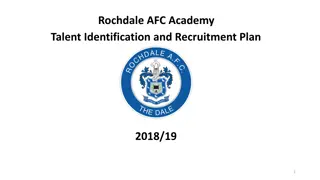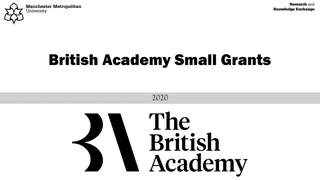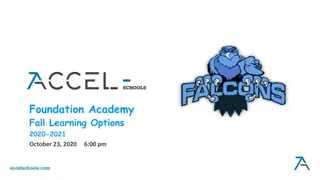
TRAC and Full Economic Cost in Higher Education Research
Learn about the Transparent Approach to Costing (TRAC) and Full Economic Cost (fEC) methodologies used in higher education to calculate the costs of research activities. This article discusses the importance of TRAC, fEC, and the different cost categories involved in building a budget for research projects.
Download Presentation

Please find below an Image/Link to download the presentation.
The content on the website is provided AS IS for your information and personal use only. It may not be sold, licensed, or shared on other websites without obtaining consent from the author. If you encounter any issues during the download, it is possible that the publisher has removed the file from their server.
You are allowed to download the files provided on this website for personal or commercial use, subject to the condition that they are used lawfully. All files are the property of their respective owners.
The content on the website is provided AS IS for your information and personal use only. It may not be sold, licensed, or shared on other websites without obtaining consent from the author.
E N D
Presentation Transcript
Grants Academy ResearchBites: Building Your Budget Aberdeen Grants Academy 5th February 2020 Research & Innovation Follow us on Twitter @UoAResInnov
WHAT IS TRAC? The Transparent Approach to Costing (TRAC) Transparent Approach to Costing (TRAC) is the methodology developed with the higher education sector to help them cost their activities to enable the calculation of the Full Economic Cost (fEC) of research and teaching. TRAC is an activity-based costing system adapted to academic culture in a way which also meets the needs of the main public funders of higher education. TRAC makes a key contribution to the understanding of sustainability and enables the calculation of the Full Economic Cost of University activities and the charge out rates for Research Estates, Indirects, Core Facilities and Technicians.
WHAT IS FULL ECONOMIC COST? Full Economic Cost (fEC) is a Government Directed standard costing methodology used for the production of consistent and transparent research project costs. HEIs use fEC to establish the true cost of research, and from this to inform the amount requested from funders (the price). The price may be below, equal or above the fEC. Understanding the true cost of a research project is critical to securing the correct level of funding in support to a project s research objectives. fEC is the only accepted basis for costing Research Applications to the UK Research Councils and to Government Departments.
COST CATEGORIES IN fEC THE THE fEC Directly Incurred costs Directly Incurred costs are project-specific (i.e. they arise as a direct consequence of the project taking place), actual, and must be auditable at the project level (e.g. supported by supplier invoices) Directly Allocated costs Directly Allocated costs are not project-specific (i.e. they are incurred whether or not the project takes place), and are estimated at project level e.g. Investigator time, Facility costs, Technician time (where not directly incurred), and Estates costs. Indirect costs Indirect costs represent the costs of central and distributed services shared by other activities that are not project-specific e.g. Library services, Finance, Human Resources, and IT. fEC COST MODEL CATEGORISES COSTS AS FOLLOWS: COST MODEL CATEGORISES COSTS AS FOLLOWS:
Building a Budget Timelines BDOs and Research Accountants should be made aware of your plans to submit an application as early as possible. At that point you may not have a draft proposal that is well enough developed to start costing but communication with R &I and Research Finance should be ongoing through the application process. A final draft budget should be ready two weeks before the deadline. Any amendments from this time on should be minor. R & I will be as flexible as possible around late applications, but please remember when we have to drop everything to deal urgently with applicants that come at the last minute, it is your colleagues that have worked hard through the whole process that will be affected.
Building a Budget where to start What are all the resources required in order to be able to deliver the project? What are the funding terms of the Funding Body Call that has been chosen? READ THE CALL GUIDANCE READ THE CALL GUIDANCE have you chosen the correct call? eg. A three year project requiring a full time Res Fellow, consumables, travel and Access to Facilities will not fit within a call that has maximum available funding of 150k Do not just reduce the costs the whole proposal has to be adapted appropriately. It will be obvious to peer reviewers whether proposed deliverables are feasible within the budget requested.
Examples of non staff budget items to be considered, depending on project Travel Costs Collaboration meetings, Steering Groups, Staff Development (Conferences etc) refer to Expenses and Benefits Policy for reference Dissemination Conferences, Workshops CPD services can assist with any conferences or workshops to be held in UoA. Note spend against the grant budget must be incurred within grant dates. Lab consumables and project specific office consumables (eg printing) Equipment refer to procurement policy Computing Costs hardware, specialised software, data storage refer to IT costing tool Outsourced Services and Sub Contracts Publishing / Open Access Staff Recruitment PPI costs PERU costs UoA Support Services and Facility Costs (see next slide)
UoA CORE FACILITIES AND SERVICES THE PI MUST DISCUSS THE WORK REQUIRED WITH THE FACILITY MANAGER, WHO WILL THE PI MUST DISCUSS THE WORK REQUIRED WITH THE FACILITY MANAGER, WHO WILL PROVIDE A QUOTE FOR THE PIECE OF WORK / SERVICE REQUIRED PROVIDE A QUOTE FOR THE PIECE OF WORK / SERVICE REQUIRED CORE FACILITIES AND SERVICES THAT ARE AVAILABLE TO ACADEMICS INCLUDE CORE FACILITIES AND SERVICES THAT ARE AVAILABLE TO ACADEMICS INCLUDE (those appearing most commonly on research grant applications are listed) MRF MICROSCOPY AND HISTOLOGY FACS MRI / IMAGING PROTEOMICS HNU CGEBM /BIOINFORMATICS COMPUTING - DATA STORAGE, HPC MAXWELL STATISTICAL SERVICES DATA SAFE HAVEN (DaSH) CLINICAL TRIALS UNIT CHaRT FACILITY MANAGERS APPROVAL FOR APPLICATIONS IS REQUIRED IN FACILITY MANAGERS APPROVAL FOR APPLICATIONS IS REQUIRED IN eAAP eAAP
Building a Budget When you are ready to start costing Contact Research Finance with the following information Funding Call and deadline date Proposed project dates Staff Resources required incl. applicant time Whether any applicants from other HEIs are involved Research Finance will check the Call Guidance, provide staff costs in the format required for the application form, if FEC costing provide investigator time costs, estates and indirects and provide a cost summary spreadsheet that can be used to collate all costs, be used as a reference and as a cost sheet for eAAP .
EXAMPLES OF APPLICATION BUDGETS PRESENT AND WORK THROUGH BUDGET FOR A RESEARCH COUNCIL PROJECT GRANT APPLICATION WET LAB BUDGET FOR A CHARITY FUNDED CALL DRY LAB
JUSTIFICATION OF RESOURCES IN THE MAJORITY OF APPLICATIONS, YOU WILL BE REQUIRED TO PROVIDE A JUSTIFICATION OF RESOURCES YOU SHOULD JUSTIFY AND EXPLAIN WHY THE RESOURCES ARE REQUIRED. DO NOT JUST RE LIST THE COSTS OF THE ITEMS REQUESTED IN THE FINANCE SECTIONS RESEARCH COUNCILS PROVIDE CLEAR GUIDES ON HOW TO WRITE A JUSTIFICATION OF RESOURCES. https://bbsrc.ukri.org/documents/justification-of-resources-guidance- pdf/
BUILDING YOUR BUDGET - RECAP From an early stage give consideration to the resources you will require in order to deliver the project. Ensure the Budget required to deliver the project fits within any funding constraints of the Funding Call chosen. Familiarise yourself with the Call Guidance eligible costs, ineligible costs Discuss requirements with facility and service managers and obtain costs. Request applicants from other HEIs to obtain their costs from their own R&I departments and to submit them to you. Provide the final budget draft and justification section to the Research Accountant allowing time for any feedback or comments to be actioned.






















